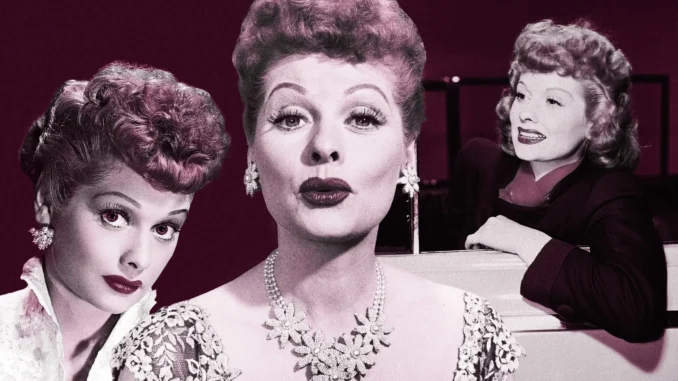
The name of series creator Gene Roddenberry appears at the end of every Star Trek episode or film. However, another television legend is equally, if not more, responsible for the massive franchise that continues today with Star Trek: Discovery Season 5 on Paramount+. If it weren’t for I Love Lucy creator Lucille Ball, Star Trek would’ve been one of the thousands of failed pilots in TV history.
Ironically, if it hadn’t failed, Strange New Worlds wouldn’t have its central characters: Captain Christopher Pike, Number One, or Mister Spock. These were the characters Roddenberry wrote into Star Trek’s pilot episode titled “The Cage.” Roddenberry took a circuitous route to television production, taking stories from his time in the military, working as a pilot and as a police officer. His first show was called The Lieutenant, from which he did most of his casting for Star Trek. However, when pitching the show to the three networks at the time, they all passed on it. Roddenberry only had a single-page memo, and Lucille Ball had the imagination the network TV executives lacked. As the head of Desilu Studio, she invested the studio’s own money to get NBC to take a chance on the revolutionary sci-fi series.
How Lucille Ball Became a Television Mogul with Star Trek and Mission: Impossible
Like many actors in her era, Lucille Ball came to Hollywood with dreams of acting, singing and dancing on the big screen. While she had some early success, she found her niche performing on a radio comedy program called My Favorite Husband. This eventually evolved into the groundbreaking I Love Lucy, a series on CBS starring Lucy alongside her then-husband Desi Arnaz. The show became a massive hit, but its longevity comes from the ingenuity of its stars.
Arnaz and Ball didn’t want their show to look blurry like their contemporaries, so they shot on 35mm film. This meant the shows could be rebroadcast repeatedly, inventing reruns and, eventually, syndication of television shows. Later, after I Love Lucy ended its run, and the two studio namesakes ended their marriage, Lucy ran the studio alone. During the height of the show’s popularity, Desilu purchased film powerhouse RKO Studios, leasing out set space to series like The Dick Van Dyke Show, The Andy Griffith Show, and countless other classic television series.
Ball wanted Desilu to own the shows filmed on its lot, too. She knew that a successful series that could air in syndication for years, or even decades, was where the real profit would be. Other executives were skeptical, but at a time when Hollywood had almost no women in positions of power, she was the deciding vote in her studio. Lucille Ball was the one who decided what series went into production and which ones didn’t, which is how the world got Star Trek.
In 1964, Gene Roddenberry, a former LA police officer and scriptwriter fresh off his first canceled series, came to Desilu and was signed to a three-year contract to create pilot episodes of TV series for the studio. He pitched many different ideas, but the one he wanted to do most was what he called “Wagon Train to the stars.” The only pilot he ever really developed was the Star Trek one, after all. Ball knew she couldn’t put all the space-eggs in one basket, so she also encouraged the development of other shows, including a spy thriller called Mission: Impossible.
Herbert F. Solow, an assitant to VP of Television at Desilu Oscar Katz, became an early champion for the show. He quickly got meetings with networks to pitch the series. Ironically, CBS (now part of Paramount) passed on the series, but the folks at NBC were interested. They commissioned a pilot called “The Cage,” starring Jeffrey Hunter as Captain Christopher Pike and Majel Barrett as his first officer, “Number One.”
How Lucille Ball Helped to Save Star Trek
NBC was willing to take a chance on Star Trek, but they weren’t fully sold. “NBC…still considered Gene a novice at the game of producing and they were not at all sure that a small studio like Desilu could produce what was, in effect, a small science-fiction movie every week,” Stephen E. Whitfield wrote in The Making of Star Trek. Still, after eight years with no new series on the air, Desilu needed the series to work as much as Roddenberry. Desilu split the $600,000 budget of “The Cage” with NBC. This arrangement mirrored how the studio would share the burden of production once the series did get picked up. This meant that each season of Star Trek cost the studio hundreds of thousands of dollars, and they wouldn’t get their money back unless it was a hit, which it didn’t seem destined to be until Lucille Ball did the unthinkable and saved Star Trek from the dustbin.
The network decided against picking up Star Trek, calling the pilot episode too cerebral and weird. Yet, Lucille Ball knew the series could work, and the producers were encouraged to keep negotiating with NBC. Ball wasn’t a fan of Star Trek, though she probably liked that Roddenberry wanted to put women characters in positions of power. Rather, she understood the potential for the series, both in the present and the future. She may not have enjoyed the business, but she knew television. This may have convinced them to give it another go. The budget for the second pilot was smaller, and filming was fraught. Director James Goldstone said he saw Lucille Ball sweeping on set, her comedic way of both showing support and telling them to finish the job. This time, with William Shatner as Captain Kirk, Leonard Nimoy as Spock and the rest of the familiar characters, the USS Enterprise took off on its journey.
